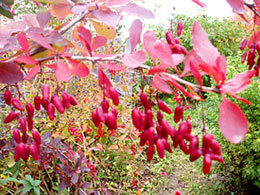
DENDROLOGICAL GARDEN
The NRIF Dendrological garden was established on July, 29 1960 on the initiative of Ivan Stepanovich Malekhov, Academician of the All-Union Academy of Agricultural Sciences.
The dendrological garden is situated near Arkhangelsk City (64° 33´  NL 39° 40´EL) on the right bank of the river Juras. The area of the garden is 44.4 ha. The garden includes: arboretum and experimental plots including introduction nursery; plantations of introduced coniferous species and tannin willows; poplar clonal archive; sea-buckthorn and high-vitamin rosehips selection plots; varietal collections of horticultural crops. About a half of the territory is occupied with north taiga forest.
NL 39° 40´EL) on the right bank of the river Juras. The area of the garden is 44.4 ha. The garden includes: arboretum and experimental plots including introduction nursery; plantations of introduced coniferous species and tannin willows; poplar clonal archive; sea-buckthorn and high-vitamin rosehips selection plots; varietal collections of horticultural crops. About a half of the territory is occupied with north taiga forest.
 NL 39° 40´EL) on the right bank of the river Juras. The area of the garden is 44.4 ha. The garden includes: arboretum and experimental plots including introduction nursery; plantations of introduced coniferous species and tannin willows; poplar clonal archive; sea-buckthorn and high-vitamin rosehips selection plots; varietal collections of horticultural crops. About a half of the territory is occupied with north taiga forest.
NL 39° 40´EL) on the right bank of the river Juras. The area of the garden is 44.4 ha. The garden includes: arboretum and experimental plots including introduction nursery; plantations of introduced coniferous species and tannin willows; poplar clonal archive; sea-buckthorn and high-vitamin rosehips selection plots; varietal collections of horticultural crops. About a half of the territory is occupied with north taiga forest.
The garden was created as the institute`s experimental base for carrying out research on introduction and acclimatization of woody plants in the European North of Russia.
At different times the garden was under the guidance of V.P. Tuleneva, T.N. Poberezhnichenko, F.T. Pigarev, L.A. Kovaleva, V.G. Bogolepov, A.V. Veretennikov, V.Ya. Popov, A.I. Ipatova, N.A. Demidova. But a particular role in the establishment of the Dendrological garden as a research centre of plant introduction to the North belongs to Vladimir Nikolaevich Nilov. Nadezhda Dmitrievna Kondratieva has worked in the garden for more than 25 years.
Important contribution to the garden`s establishment was made by: L.G. Kryzhanovskaya, O.I. Komissarova, L.G. Koshel, V.I. Bormotov, B.L. Stafeev, M.A. Pavlova, V.O. Fomina, T.L. Kolesnichenko and many others who have worked here for years.
Today the main directions of the Dendrological garden activity are:
- Conduction of long-term experimental and experiment-production works in the area of plant introduction and acclimatization. Revelation of their profitability in the conditions of the North. Introduction of the most valuable of them into culture.
- Maintenance and concervation of the woody plants collection. Introduction of rare and endangered species of local fauna into its composition with a purpose of preservation of their gene pool.
- Maintenance of the collection fund of the garden. Carrying out required observations and attendance of the plants.
- Development of recommendations on landscape gardening in urban districts and settlements in the Northern conditions.
- Development of recommendations on recultivation of lands damaged with industrial activity or suffering from adverse effects of the environment with fitting of optimal composition of plant species for cultivation of such lands.
- Conduction of enlightening and educational works in the field of botany, conservancy, ecology, plant cultivation and landscape gardening.
- Promotion of forestry achievements and advanced experience.



